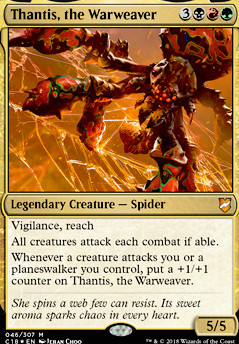Creature (30)
- 1x AEther Membrane
- 1x Accursed Witch Flip
- 1x Amaranthine Wall
- 1x Ancient Stone Idol
- 1x Archers' Parapet
- 1x Axebane Guardian
- 1x Banshee of the Dread Choir
- 1x Bitterheart Witch
- 1x Carven Caryatid
- 1x Fumiko the Lowblood
- 1x Goblin Spymaster
- 1x Hornet Nest
- 1x King Macar, the Gold-Cursed
- 1x Nesting Dragon
- 1x Overgrown Battlement
- 1x Poison-Tip Archer
- 1x Royal Assassin
- 1x Sakura-Tribe Elder
- 1x Shirei, Shizo's Caretaker
- 1x Sprouting Phytohydra
- 1x Tree of Perdition
- 1x Tree of Redemption
- 1x Varchild, Betrayer of Kjeldor
- 1x Vine Trellis
- 1x Wall of Blossoms
- 1x Wall of Earth
- 1x Wall of Granite
- 1x Wall of Heat
- 1x Wall of Razors
- 1x Wall of Stone
Enchantment (17)
- 1x Aspect of Gorgon
- 1x Assault Formation
- 1x Cruel Reality
- 1x Curse of Bloodletting
- 1x Curse of Disturbance
- 1x Curse of Marit Lage
- 1x Curse of Misfortunes
- 1x Curse of Opulence
- 1x Curse of Predation
- 1x Rite of the Raging Storm
- 1x Sandwurm Convergence
- 1x Shadows of the Past
- 1x Torment of Scarabs
- 1x Treefolk Umbra
- 1x Trespasser's Curse
- 1x Vow of Malice
- 1x Vow of Wildness
Instant (6)
Artifact (4)
Commander (1)
Land (35)
- 1x Bojuka Bog
- 1x Command Tower
- 1x Evolving Wilds
- 10x Forest
- 9x Mountain
- 1x Savage Lands
- 11x Swamp
- 1x Terramorphic Expanse
Sorcery (5)
Planeswalker (2)
Maybeboard
Creature (23)
- 1x Agitator Ant
- 1x Archetype of Finality
- 1x Aura Gnarlid
- 1x Blightcaster
- 1x Butcher of Malakir
-
1x
Calculating Lich

- 1x Cemetery Gate
- 1x Clackbridge Troll
- 1x Corpse Blockade
- 1x Dread
- 1x Goblin Diplomats
- 1x Jungle Patrol
- 1x Manor Gargoyle
- 1x Pharika's Mender
- 1x Seedborn Muse
- 1x Thoughtrender Lamia
- 1x Vent Sentinel
- 1x Wall of Bone
- 1x Wall of Mulch
- 1x Warmonger Hellkite
-
1x
Xantcha, Sleeper Agent

- 1x Xathrid Gorgon
Enchantment (16)
- 1x Captive Audience
- 1x Curse of Fool's Wisdom
- 1x Curse of Oblivion
- 1x Curse of Shallow Graves
- 1x Curse of Thirst
- 1x Curse of Vengeance
- 1x Curse of Wizardry
- 1x Curse of the Nightly Hunt
- 1x Grand Melee
- 1x Koskun Falls
- 1x Marchesa's Decree
- 1x Nettling Curse
- 1x Parasitic Impetus
- 1x Predatory Impetus
- 1x Shiny Impetus
- 1x Vow of Lightning
Sorcery (5)
Artifact (12)
- 1x Assault Suit
- 1x Cursed Rack
- 1x Cursed Totem
- 1x Dragon Throne of Tarkir
- 1x Golgari Signet
- 1x Gruul Signet
- 1x Lifecrafter's Bestiary
- 1x Loxodon Warhammer
- 1x Peregrine Mask
- 1x Rakdos Signet
- 1x Ring of Kalonia
- 1x Ring of Valkas
Instant (5)
Planeswalker (1)
Suggestions
Comments
Attention! Complete Comment Tutorial! This annoying message will go away once you do!
Important! Formatting tips — Comment Tutorial — markdown syntax
Please login to comment
92% Casual
Competitive
| Date added | 4 years |
| Last updated | 3 years |
| Key combos | |
| Legality | This deck is Commander / EDH legal. |
| Rarity (main - side) | 5 - 0 Mythic Rares 19 - 0 Rares 24 - 0 Uncommons 22 - 0 Commons |
| Cards | 100 |
| Avg. CMC | 3.52 |
| Tokens | Beast 3/3 B, Construct 6/12 C, Copy Clone, Dragon 2/2 R, Dragon Egg 0/2 R, Emblem Garruk, Apex Predator, Goblin 1/1 R for Goblin Spymaster, Gold, Human 2/2 G, Insect 1/1 G w/ Flying, Deathtouch, Lightning Rager, Plant 0/2 G, Survivor 1/1 R, Wolf 1/1 B, Wolf 2/2 G, Wurm 5/5 G, Zombie 2/2 B |
| Votes | |
| Ignored suggestions | |
| Shared with | |
| Views |


